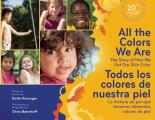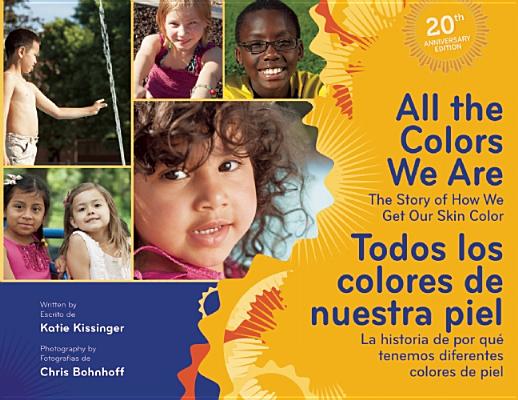Reviewed by Rethinking Schools
Book Author: Katie Kissinger
We’re delighted to see this 20th anniversary edition of Katie Kissinger’s classic book, All the Colors We Are. Kissinger—author of the memorable Rethinking Schools article “Holding Nyla”—has written a book that deals with skin color in a straightforward, scientifically accurate, child-friendly manner. Young children are curious about why people have different skin colors, and too often teachers are tempted to brush this curiosity aside in the name of a glib “We’re all the same.” The book is the product of Kissinger’s years-long work with children, and features valuable teaching suggestions to get children thinking imaginatively and unself-consciously about skin color. The book, including teaching ideas, is fully bilingual in English and Spanish.
Teaching Ideas
Before Reading Questions:
- Looking at the cover, what do you think this book will be about?
- Do you see anyone who looks like someone you know?
- Who can read the title?
This is a book about how we get our skin color!
During Reading Questions:
- The book includes several questions – pause and call on a few children to answer them as appropriate.
- p. 11 says if your skin is dark the melanin is very active, but if light it is not very busy.
- “What do you think the melanin is doing in your skin if it’s very active? What do you think the melanin is doing in your skin if it is not very busy? (Encourage kids to wiggle and act it out!)
- p. 16, ask kids “How do you protect your skin from sunburn?” Answers may include sunscreen or shade.
- Ask children to raise their hands if they think their families and ancestors came from:
- somewhere with a lot of sun and heat. (dark skin)
- somewhere with a little sun and heat. (light skin)
- somewhere in between or a mix.
After reading:
- Ask kids if they remember what color everyone’s skin actually is? (Brown!)
- Ask if they remember what causes the color of our skin?
- Parents and ancestors (family)
- the sun
- melanin
- Have all of the students stand up. Remind them that melanin is more active in dark skin, and less busy in light skin. Tell them on the count of three everyone is going to wiggle, and if they have a lot of melanin they should wiggle a lot, if they have a little melanin they should wiggle a little, and in-between. Stand up with the kids and everyone wiggle based on their melanin
- Science notes: All living things have pigment, and pigment makes color. Melanin is a pigment that forms the shades of brown. Melanin also causes a zebra’s stripes, a leopard’s spots, and a frog’s speckles. In addition to their skin, people have melanin pigment in their eyes and hair too.
Follow-up Activity:
- Teachers can do activities with colors or maps to reinforce the idea that skin color means how active the melanin is in our skin.
- Two people with different color skin may have more in common than two people with the same color skin! Talk with students about how skin color is only “skin deep” and look at the ways in which humans are more similar than different.


All the Colors We are by Katie Kissinger
Illustrator: Chris Bohnhoff
Published by Zaner-Bloser on 2013
Genres: Early Childhood Anti-Bias, Read Alouds, Banned Books
Pages: 32
Reading Level: Early Childhood, Grade K, Grades 1-2
ISBN: 9780736793223
Review Source: Rethinking Schools
Buy at Powell's Books
Also by this author: Anti-Bias Education in the Early Childhood Classroom
Publisher's Synopsis: Explains, in simple terms, the reasons for skin color, how it is determined by heredity, and how various environmental factors affect it.

Leave a Reply